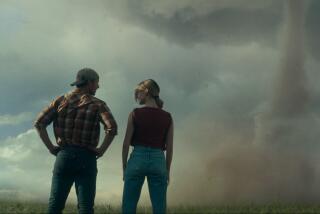There’s Water, Water, Virtually Everywhere
The main character in “The Perfect Storm” is, well, a storm. It’s not just any storm, of course, but what was widely considered the storm of the century, which occurred when three weather systems collided off the coast of New England in October 1991. The effect was devastating: 100-foot waves, 120 mph winds. In its path was an assortment of fishing boats, cargo ships, yachts and aircraft.
“The Perfect Storm,” adapted from Sebastian Junger’s bestseller, focuses on a handful of these vessels, principally the Andrea Gail and also, to a lesser degree, the sloop Satori and the helicopter that comes to rescue her.
In years past, this sort of thing would have been depicted on screen with the use of miniatures and tight shots of men being tossed around, as if in a washing machine. Such scenes lacked a sense of scale, and if the filmmakers tried to give them that, they looked like what they were--fake.
Now comes Industrial Light & Magic, the first and last word in digital effects, having given us cyborgs and ghosts and dinosaurs and tornadoes, among other wonders. According to “Perfect Storm” visual effects supervisor Stefen Fangmeier (“Saving Private Ryan,” “Twister,” “Jurassic Park”), creating the storm was in some ways more challenging than these other exercises, because an entire environment had to be generated, not just parts of one.
“It has never really been created digitally in a computer,” he says. “And yet I think there is no other way to tell the story. This is certainly not a fantasy. This is not a ‘Godzilla,’ a ‘Jurassic Park,’ where the audience looks at whatever we produce and says, ‘I know in the back of my mind this is not real, but they made it look pretty real, so I’m going along with them.’ Here we’re looking at something real.”
Fangmeier had more than 100 artists assisting him, as many as were used on “Star Wars: Episode I The Phantom Menace.” Their first task was to do research and development. They learned about wave height and speed, modeled the physics of how the boat would interact with the water, watched videos taken on board fishing boats during storms and footage from the disastrous 1998 Sydney-to-Hobart yacht race. Fangmeier also had the advantage of seeing firsthand the effects of such winds, having been among the crew members who sat out the hurricane that wrecked the set of “Jurassic Park” in Hawaii.
To create the roughly 300 computer-generated shots in the film, ILM layered in detail upon detail, starting with the ocean and moving on to the wave speed, the crests on the waves, the wind, the mist from the wind, the splash around the boat, even the crew. It’s all lighted by lightning flashes--which create a strobe-like effect, freezing the ship in place--and combined with live-action footage taken at sea and also in a water tank.
“The water always has to have the right level of detail,” Fangmeier says. “You can’t overemphasize it because it looks like a sandblasted surface, like coarse rock. When you make it too smooth, it starts looking like metal. And the mist. If it stays visible too long after it detaches from the wave, it starts looking like puffy smoke. If not, it starts looking like soapy stuff. There is a very small range of flexibility there. If it’s even 5% off, too dense, too bright, too white, it blows the whole illusion of the scene.”
Obviously the effects people were under pressure to make sure that the storm lives up to the title, but it can’t seem too farfetched. What audiences will see is more or less realistic, with some sequences amped up because a camera angle might make the waves look too small (in “Jurassic Park,” for example, the Tyrannosaurus rex was sometimes 24 feet tall, sometimes 30) or simply for dramatic effect.
“It’s that fine line between making a great impact with every shot and also staying scientifically accurate,” Fangmeier says. On the other hand, he adds dryly, “that last 10 minutes of the storm needs to be fairly over the top.”
More to Read
The biggest entertainment stories
Get our big stories about Hollywood, film, television, music, arts, culture and more right in your inbox as soon as they publish.
You may occasionally receive promotional content from the Los Angeles Times.










